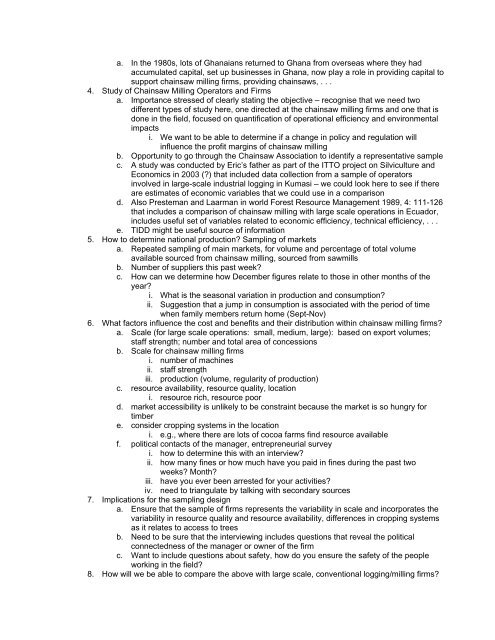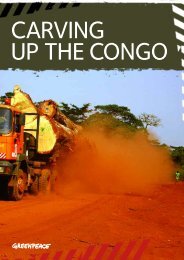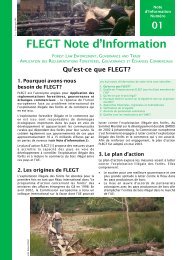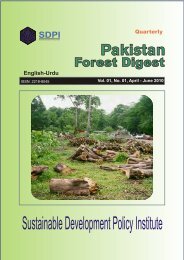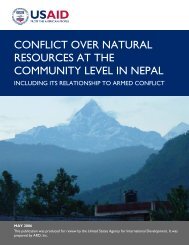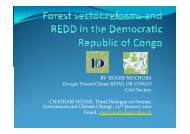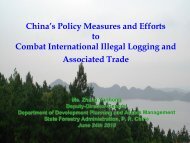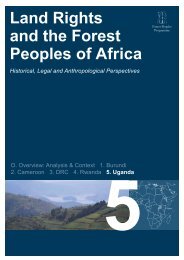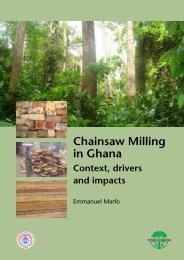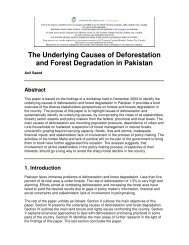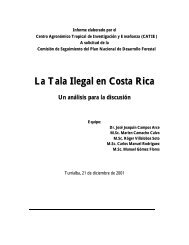chainsaw milling and lumber trade in west africa project
chainsaw milling and lumber trade in west africa project
chainsaw milling and lumber trade in west africa project
You also want an ePaper? Increase the reach of your titles
YUMPU automatically turns print PDFs into web optimized ePapers that Google loves.
a. In the 1980s, lots of Ghanaians returned to Ghana from overseas where they hadaccumulated capital, set up bus<strong>in</strong>esses <strong>in</strong> Ghana, now play a role <strong>in</strong> provid<strong>in</strong>g capital tosupport <strong>cha<strong>in</strong>saw</strong> <strong>mill<strong>in</strong>g</strong> firms, provid<strong>in</strong>g <strong>cha<strong>in</strong>saw</strong>s, . . .4. Study of Cha<strong>in</strong>saw Mill<strong>in</strong>g Operators <strong>and</strong> Firmsa. Importance stressed of clearly stat<strong>in</strong>g the objective – recognise that we need twodifferent types of study here, one directed at the <strong>cha<strong>in</strong>saw</strong> <strong>mill<strong>in</strong>g</strong> firms <strong>and</strong> one that isdone <strong>in</strong> the field, focused on quantification of operational efficiency <strong>and</strong> environmentalimpactsi. We want to be able to determ<strong>in</strong>e if a change <strong>in</strong> policy <strong>and</strong> regulation will<strong>in</strong>fluence the profit marg<strong>in</strong>s of <strong>cha<strong>in</strong>saw</strong> <strong>mill<strong>in</strong>g</strong>b. Opportunity to go through the Cha<strong>in</strong>saw Association to identify a representative samplec. A study was conducted by Eric’s father as part of the ITTO <strong>project</strong> on Silviculture <strong>and</strong>Economics <strong>in</strong> 2003 (?) that <strong>in</strong>cluded data collection from a sample of operators<strong>in</strong>volved <strong>in</strong> large-scale <strong>in</strong>dustrial logg<strong>in</strong>g <strong>in</strong> Kumasi – we could look here to see if thereare estimates of economic variables that we could use <strong>in</strong> a comparisond. Also Presteman <strong>and</strong> Laarman <strong>in</strong> world Forest Resource Management 1989, 4: 111-126that <strong>in</strong>cludes a comparison of <strong>cha<strong>in</strong>saw</strong> <strong>mill<strong>in</strong>g</strong> with large scale operations <strong>in</strong> Ecuador,<strong>in</strong>cludes useful set of variables related to economic efficiency, technical efficiency, . . .e. TIDD might be useful source of <strong>in</strong>formation5. How to determ<strong>in</strong>e national production? Sampl<strong>in</strong>g of marketsa. Repeated sampl<strong>in</strong>g of ma<strong>in</strong> markets, for volume <strong>and</strong> percentage of total volumeavailable sourced from <strong>cha<strong>in</strong>saw</strong> <strong>mill<strong>in</strong>g</strong>, sourced from sawmillsb. Number of suppliers this past week?c. How can we determ<strong>in</strong>e how December figures relate to those <strong>in</strong> other months of theyear?i. What is the seasonal variation <strong>in</strong> production <strong>and</strong> consumption?ii. Suggestion that a jump <strong>in</strong> consumption is associated with the period of timewhen family members return home (Sept-Nov)6. What factors <strong>in</strong>fluence the cost <strong>and</strong> benefits <strong>and</strong> their distribution with<strong>in</strong> <strong>cha<strong>in</strong>saw</strong> <strong>mill<strong>in</strong>g</strong> firms?a. Scale (for large scale operations: small, medium, large): based on export volumes;staff strength; number <strong>and</strong> total area of concessionsb. Scale for <strong>cha<strong>in</strong>saw</strong> <strong>mill<strong>in</strong>g</strong> firmsi. number of mach<strong>in</strong>esii. staff strengthiii. production (volume, regularity of production)c. resource availability, resource quality, locationi. resource rich, resource poord. market accessibility is unlikely to be constra<strong>in</strong>t because the market is so hungry fortimbere. consider cropp<strong>in</strong>g systems <strong>in</strong> the locationi. e.g., where there are lots of cocoa farms f<strong>in</strong>d resource availablef. political contacts of the manager, entrepreneurial surveyi. how to determ<strong>in</strong>e this with an <strong>in</strong>terview?ii. how many f<strong>in</strong>es or how much have you paid <strong>in</strong> f<strong>in</strong>es dur<strong>in</strong>g the past twoweeks? Month?iii. have you ever been arrested for your activities?iv. need to triangulate by talk<strong>in</strong>g with secondary sources7. Implications for the sampl<strong>in</strong>g designa. Ensure that the sample of firms represents the variability <strong>in</strong> scale <strong>and</strong> <strong>in</strong>corporates thevariability <strong>in</strong> resource quality <strong>and</strong> resource availability, differences <strong>in</strong> cropp<strong>in</strong>g systemsas it relates to access to treesb. Need to be sure that the <strong>in</strong>terview<strong>in</strong>g <strong>in</strong>cludes questions that reveal the politicalconnectedness of the manager or owner of the firmc. Want to <strong>in</strong>clude questions about safety, how do you ensure the safety of the peoplework<strong>in</strong>g <strong>in</strong> the field?8. How will we be able to compare the above with large scale, conventional logg<strong>in</strong>g/<strong>mill<strong>in</strong>g</strong> firms?


